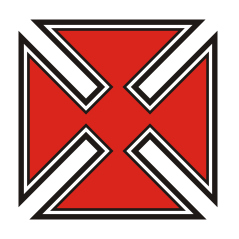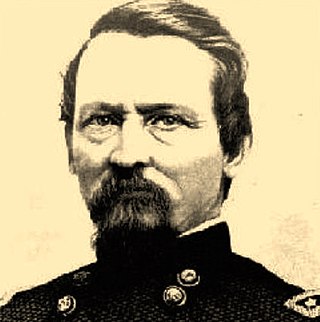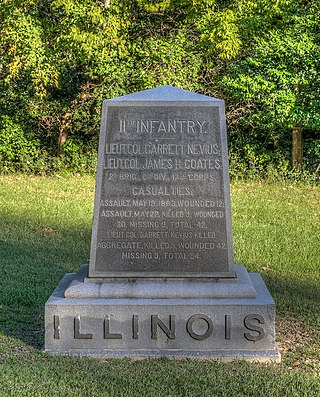The Confederate order of battle during the Battle of Gettysburg includes the American Civil War officers and men of the Army of Northern Virginia. Order of battle compiled from the army organization during the battle, the casualty returns and the reports.

The First Battle of Fort Fisher was a naval siege in the American Civil War, when the Union tried to capture the fort guarding Wilmington, North Carolina, the South's last major Atlantic port. Led by Major General Benjamin Butler, it lasted from December 24–27, 1864.

XIX Corps was a corps of the Union Army during the American Civil War. It spent most of its service in Louisiana and the Gulf, though several units fought in Virginia's Shenandoah Valley.
The following Confederate States Army units and commanders fought in the American Civil War's Second Battle of Kernstown on July 24, 1864, in Kernstown, now part of the Virginia city of Winchester. The Union order of battle is shown separately.
The following Union Army units and commanders fought in the Battle of Stones River of the American Civil War. The Confederate order of battle is listed separately. Order of battle compiled from the army organization during the campaign, the casualty returns and the reports.
The following Union Army units and commanders fought in the Siege of Vicksburg of the American Civil War. The Confederate order of battle is listed separately. Order of battle compiled from the army organization during the campaign.
The following Union Army units and commanders fought in the Battle of the Wilderness of the American Civil War. The Confederate order of battle is listed separately. Order of battle compiled from the army organization May 5, 1864, the casualty returns and the reports.
The following units and commanders of the Union Army fought at the Siege of Corinth of the American Civil War. The Union Army had approximately 150,000 present for duty. The Confederate order of battle is shown separately. Order of battle compiled from the army organization during the siege.

James Clifford Veatch was a lawyer who served as an Indiana state legislator and county auditor. He later served as a Union general during the American Civil War, fighting primarily in the Western Theater. He rose to command of a division of infantry and fought in several important battles.
The following Union Army units and commanders fought in the Battle of Chaffin's Farm of the American Civil War. The Confederate order of battle is shown separately.
The following Union Army units and commanders fought in the Battle of Ball's Bluff of the American Civil War, fought from October 20 to October 24, 1861, in Loudoun County, Virginia, also known as the Battle of Leesburg or the Battle of Harrison's Island. The Confederate order of battle is shown separately.
The following Union Army units and commanders fought in the Battle of Wilmington of the American Civil War. The Confederate order of battle is listed separately.
The following Union Army units and commanders fought in the Battle of Fort Stevens of the American Civil War on July 11–12, 1864. The Confederate order of battle is listed separately.
The following Union Army units and commanders fought in the Siege of Charleston Harbor of the American Civil War. The Confederate order of battle is listed separately.

The following Union Army units and commanders fought in the Knoxville Campaign and subsequent East Tennessee operations during the American Civil War from November 4 to December 23, 1863 under the command of Maj. Gen. Ambrose E. Burnside. Engagements fought during this time included the battles of Campbell's Station and Fort Sanders and the siege of Knoxville. Order of battle compiled from the army organization during the campaign and return of casualties. The Confederate order of battle is shown separately.
The following units and commanders fought in the Chattanooga–Ringgold campaign of the American Civil War on the Union side. The Confederate order of battle is shown separately. Order of battle compiled from the army organization during the campaign, the casualty returns and the reports.
The following Union Army units and commanders were the initial structure on April 4, 1862 of the Union Department of the Potomac during the Peninsula campaign of the American Civil War. This list includes units deployed to the Virginia Peninsula, and those that remained in the Washington area. The Confederate order of battle is listed separately.
The following Union Army units and commanders fought in the Battle of Boydton Plank Road of the American Civil War. Order of battle compiled from the casualty returns.

The 11th Regiment Illinois Volunteer Infantry was an infantry regiment from Illinois that served in the Union Army during the American Civil War. In April 1861, it was formed as a three-month volunteer unit, and in July 1861 it was reorganized as a three-year unit, in which role it served until the end of the war. Two of its commanding officers were promoted to brigadier general and led major units during the war. In its first major action at Fort Donelson the regiment suffered terrible losses. The 11th Illinois also fought at Shiloh, Riggins Hill, Vicksburg, First Yazoo City, Second Yazoo City, and Fort Blakely. In April 1863, the 109th Illinois Infantry Regiment was disbanded and its enlisted men transferred into the 11th Illinois. The regiment was mustered out of service in July 1865.
The following Confederate Army units and commanders fought in the Mobile campaign of the American Civil War including the battles of Spanish Fort and Fort Blakeley. The Union order of battle is shown separately.
This page is based on this
Wikipedia article Text is available under the
CC BY-SA 4.0 license; additional terms may apply.
Images, videos and audio are available under their respective licenses.





